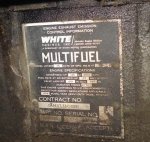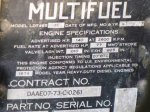There is that math.../. about torque versus horsepower in DIN or KW or Joules or whatever
All you need to no is that torque means more about horsepower than horsepower does.
No matter what has been built as a motive force as a heat engine it is always about that
one sweet spot whereas the torque and horsepower cross.
All one really needs is that specific torque delivered within the specific fuel consumption
as per design and then add all the gears within reason to run the motive force at it's peak torque.
i.e. get a diesel and lots of gears and stay within the "power band" to do the most work for
cheapest for a particular application.
pyrometers are a solution To enable NOT melting the metal.
Diesels run wild run given enough fuel and will blow themselves away
A M.A.N. Hypercycle is a diesel.
You don't control the oxygen input, you control only the fuel input.
and this is from SS, not me.............................
In a nutshell: The injector squirts a stream of fuel into a cup in the top of the piston. As it evaporates from the cup, it burns and expands, pushing the piston down. Conventional diesels inject a mist into the cylinder that burns immediately. The evaporation lag is what allows the engine to burn "hot" fuels such as gasoline, without detonation, or the fuel exploding rather than burning. M.A.N., a German company, invented this engine design. Continental called it "Hypercycle".
really its 22-1 comp.
And they are still mult-fuel even with the fuel density compensator bypassed!! Its mostly in the way the piston/combustion chamber is designed.
__________________
I've been too busy/lazy until now to bother looking into it, but I'm curious. How does these multifuel engines actually work? Why are these engines able to run on all these different fuels?
Extremely high compression (~27:1) and extra attention paid to the fuel atomization/spray pattern help to burn different fuels. There is also a fuel density compensator to help with the air/fuel ratio. There is probably also some secret magic voodoo mixed in somewhere
I hate to break it to you but the LDS is just a Diesel Engine, just like any other Diesel engine it can run a greater variety of fuels than a gasoline engine. The real heart of the system to maintain power is the FDC... That is what makes it run other fuels efficiently.
I know you people think there is something mystical to the engine in the internal structure but it just a diesel engine. The Cummins C-Series engine when used by the military will run on Jet-A, Kerosene, Fuel Oil as well as Diesel and there are no differences between Military ISC engine and the civilian one(even the Military DT-466 is rated to use other fuels no changes however, from the civilian DT-466). The only feature that makes the LDT-465 a true multi-fuel engine is the FDC which allows the engine to run on fuels with a lower oil content than a normal diesel engine would run on effectively.
Even the name LD means Liquid Cooled Diesel Engine. I mean everything about this engine is a diesel engine. The only key to running stuff like Gasoline or a mix of Diesel and Gas is the FDC... Bypass that and the engine will run, but it will produce less power, get poor fuel mileage, smoke more possible under loads.
Hey .......................................
Merry Christmas




